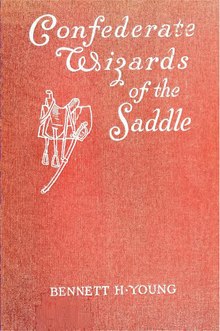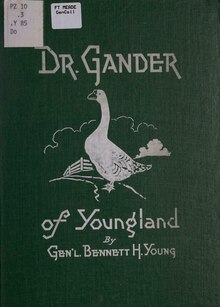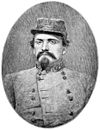| Bennett H. Young | |
|---|---|
 | |
| Born | (1843-05-25)May 25, 1843 Nicholasville, Kentucky, U.S. |
| Died | February 23, 1919(1919-02-23) (aged 75) Louisville, Kentucky, U.S. |
| Resting place | Cave Hill Cemetery Louisville, Kentucky, U.S. |
| Spouses |
|
| Children | 2 |
| Military career | |
| Allegiance | |
| Service | Confederate States Army |
| Years of service | 1861–1865 |
| Signature | |
Bennett Henderson Young (May 25, 1843 – February 23, 1919) was a commanding officer, lawyer, administrator, and author. As a Confederate officer he led forces in the St. Albans Raid (October 19, 1864) during the American Civil War. As a lieutenant of the Confederate States Army, he entered Vermont from Canada and occupied the town of St. Albans.
Early life
Young was born in Nicholasville, Kentucky, on May 25, 1843, to Robert Young and Josephine Henderson. He was 17 years old when he enlisted as a private in the Confederate 8th Kentucky Cavalry. This unit became a part of John Hunt Morgan's cavalry command.
St. Albans raid
Young was captured in Morgan's Raid but fled to Canada in the fall of 1863. Young traveled back to the Confederacy via Nova Scotia and Bermuda, where he proposed Canada-based raids on the United States as a means of building the Confederate treasury and forcing the Union Army to protect their northern border as a diversion. Young was commissioned as a lieutenant and returned to Canada, where he recruited other escaped rebels to participate in the October 19, 1864, raid on St. Albans, Vermont, a quiet town 15 miles (25 km) from the Canada–US border.

Young and two others checked into a local hotel on October 10, saying they had come from St. John's in Canada for a "sporting vacation." Every day, two or three more young men arrived. By October 19, there were 21 cavalrymen assembled; just before 3:00 p.m. the group simultaneously staged an armed robbery of the three banks in St. Albans. They announced that they were Confederate soldiers and stole a total of $208,000 ($4,052,000 in current dollar terms). As the banks were being robbed, eight or nine of the Confederates held the townspeople prisoner on the village green as their horses were stolen. The Confederates killed one townsperson and wounded another. Young ordered his troops to burn the town down, but the four-ounce bottles of Greek fire they had brought failed to work, and only one shed was destroyed.
The raiders fled with the money into Canada, where authorities arrested them and held them in Montreal. There, the Lincoln administration retained prominent Irish-Canadian lawyer Bernard Devlin, QC, as counsel for the prosecution in the subsequent court case, which sought the raiders' extradition. The court ultimately decided that the soldiers were under military orders and that the officially neutral Canada could not extradite them to America. They were freed, but the $88,000 ($1,714,000 in current dollar terms) the raiders had on them was returned to Vermont.
Later career
After the end of the Civil War, Young was excluded from President Andrew Johnson's amnesty proclamation. He could not return home until 1868. Thus, he spent time studying law and literature in Ireland at the Queen's University of Ireland and at the University of Edinburgh.

After being permitted to return to the United States, he became an attorney in Louisville, Kentucky. Young founded the first orphanage for black children in Louisville, a school for blind students, and did pro bono work for people experiencing poverty. He also worked as a railroad officer as President of the Louisville Southern Railroad, and wrote books. Young also served on the board of trustees of the Confederate Veteran.
In 1876, Young was selected by Governor James B. McCreary to represent Kentucky at the Paris Exposition of 1878.
In 1878, Young joined the Polytechnic Society of Kentucky as a financier to the institution. Young became president of the society after the death of Dr. Stuart Robinson.
In 1899, Young represented a formerly enslaved person, George Dinning, in a case against the Ku Klux Klan.
Between 1890 and 1908, Young helped create the Louisville Free Public Library.

In 1913, Young was elected commander-in-chief of the United Confederate Veterans, which he held until his retirement in 1916, where he was made "honorary commander-in-chief for life."
Family life
In 1866, Young married Mattie R. Robinson, and they had a son Lawrence, who became an attorney in Chicago. He remarried in 1895 to Eliza S. Sharp, and they had a daughter, Eliza Bennett Young.
List of works
- The Prehistoric Men of Kentucky
- The History of the Kentucky Constitution

- Evangelistic Work in Kentucky
- Battle of Blue Licks
- The History of Jessamine County
- The History of the Division of the Presbyterian Church in Kentucky
- The Battle of the Thames
- Dr. Gander of Youngland
- Kentucky Eloquence
- Confederate Wizards of the Saddle
Death and legacy
By 1908, Young was known as "the father of the Louisville Free Public Library."
Young died on February 23, 1919, at his home at 429 West Ormsby Avenue in Louisville, Kentucky. He was buried at Cave Hill Cemetery in Louisville.
The railroad bridge over the Kentucky River at Tyrone, Kentucky was named Young's High Bridge for him, and Youngstown, Kentucky was also named for him.
See also
Portal:References
- ^ "Gen. Young, lawyer and soldier, dies". The Courier-Journal. February 24, 1919. p. 1. Retrieved November 10, 2019.
- Simpson, John A. (2003). Edith D. Pope and Her Nashville Friends: Guards of the Lost Cause in the Confederate Veteran. Knoxville, Tennessee: University of Tennessee Press. p. 32. ISBN 9781572332119. OCLC 428118511.
- ^ "Gen. B.H. Young, Soldier, Dies". The Courier-Journal. February 24, 1919. p. 3. Retrieved November 10, 2019.
- Breyer, William (1944). Lotteries and Libraries: History of the Louisville Free Public Library. Cynthiana, Ky.: Hobson Press. p. 75.
- ^ Hall, Wade (1978). Louisville 200: Reflections of a city. Friends of the Louisville Free Public Library, 1978. OCLC 4788203.
- "General Young is Laid to Rest". The Leaf-Chronicle. 1919-02-25. p. 8. Retrieved 2022-06-13 – via Newspapers.com.

External links
- Bennett H. Young
- The St. Albans raid
- St. Albans Raid: Spies, Raiders and Partisans
- "Bennett H. Young". Find a Grave. Retrieved 2008-02-14.
- McAfee, John J. (1886). Kentucky politicians : sketches of representative Corncrackers and other miscellany. Louisville, Kentucky: Press of the Courier-Journal job printing company. pp. 176–180.
| Morgan's Raiders | ||
|---|---|---|
| People |  | |
| Places | ||
| Battles/Raids | ||
- Terrorist incidents in the United States by perpetrator
- 1843 births
- 1919 deaths
- People from Nicholasville, Kentucky
- Businesspeople from Louisville, Kentucky
- Confederate States Army officers
- St. Albans, Vermont
- Burials at Cave Hill Cemetery
- People of Kentucky in the American Civil War
- Alumni of the University of Edinburgh
- Writers from Louisville, Kentucky
- Kentucky lawyers
- 19th-century American businesspeople
- 19th-century American lawyers